Pictures of British Country Life


1.
JOHN FREDERICK
SR. (British, 1795-1865)
HERRING,
Farmyard Scene Signed
Oil on canvas, 16 inches diameter




1.
JOHN FREDERICK
SR. (British, 1795-1865)
Farmyard Scene Signed
Oil on canvas, 16 inches diameter

a catalog presented in collaboration
PETER L. VILLA FINE ART, LLC American & European Paintings from the 18th – 21st Centuries

P.O. Box 143 – 10 Todd Avenue Peapack, New Jersey 07977 In New York by Appointment 212-371-1196 peter@plvillafineart.com www.peterlvillafineart.com and
P.O. Box 385 – 1 North Madison Street Middleburg, Virginia 20117 703-851-5160
F. Turner Reuter, Jr. tr@redfoxfineart.com www.redfoxfineart.com
We are pleased to present this third collaborative catalogue of fine sporting paintings which illustrates the great diversity of British country life over the past two centuries.
At the turn of the nineteenth century the English nobility arrived at the racecourse in a large and colorful variety of road coaches and private liveried carriages. Their champion thoroughbreds were paraded, the trainers were consulted, and the jockeys were given last minute instructions as wagers were tallied at the betting posts. Concurrently throughout the British Isles, sportsmen boldly followed hounds on horseback, shot game birds over prized gun dogs, and sought out the best chalk streams and rivers to angle for salmon and trout with fly and rod.
In due course, this enthusiasm for field sports was transported to America where distinct and unique traditions were developed in the diverse variety of our new nation’s landscapes. Today our opportunities may be fewer, but the experience and tradition are no less rewarding. In each generation artists have painted the sporting life with great skill and affection, and we hope you will find our selection of Pictures of British Country Life representative of some of the best of the genre.
Please note that all paintings are offered subject to prior sale. Artworks can be viewed by appointment, or by delivery to the buyer’s location on approval. Prices, provenance and full details of each entry are available on request.
Peter L. Villa F. Turner Reuter, Jr. Hannah R. Rothrock(British, 1756-1815) Dapping for Trout Oil on panel, 9½ x 12½ inches

JOHN
(British, 1795-1865)
Deer Park at Windsor Signed and dated 1835
Oil on panel, 10 x 12 inches

a catalog presented in collaboration
Copyright 2022 Peter L. Villa Fine Art, LLC / Red Fox Fine Art
All rights reserved.
No part of this publication may be reproduced, or stored in a retrieval system, or transmitted in any form or by any means - electronic, mechanical, photocopying, recording, or otherwisewithout written permission of the publishers.
ISBN: 979-8-218-08685-5 Library of Congress Control Number: 2022918941
Published in the United States by Peter L. Villa Fine Art, LLC & Red Fox Fine Art
Printed in the U.S.A. by District Creative Printing, 6350 Fallard Drive, Upper Marlboro, Maryland
Layout and Design: Andrew Hock
Artwork Photography: Brandon Webster Mariah Texidor
Front Cover: SAWREY GILPIN and GEORGE BARRET Going Out in the Morning, Foxhunting with HRH the Prince of Wales (detail) Plate 5
Intro Page: SIR ALFRED JAMES MUNNINGS, PRA Kempton Park Stables (detail) Plate 26
(British, 1792-1867)
Departure of the Royal Mails, The General Post Office, London Oil on canvas, 18 x 24½ inches

Departure of the Royal Mails, The General Post Office, London
Provenance:
Wildenstein Gallery, New York, NY
Peter H.B. Frelinghuysen, Morristown, New Jersey
By descent in the family until the present
The General Post Office building was one of the great architectural feats of its time. It was erected in 1829 and was designed by Sir Robert Smirke. This view was painted in the same year to commemorate the completion of the building. From here the Postmaster General directed the central offices of the letter, newspaper, and later, the telegraph departments of England.
In the 1820s all the Royal Mails, apart from those for the West Country, left at 8pm precisely from the General Post Office in Lombard Street. Crowds would gather to watch the spectacle. Traveling by Royal Mail was the fastest, smartest and most expensive mode of public transportation. The first mail coaches were introduced in 1784, replacing the post boys who had frequently been attacked by highwaymen. By 1829 the coaches were light vehicles carrying four passengers inside and four out. They could achieve 12 miles per hour, with teams of horses changed in as little as two minutes. Mails paid no tolls and the toll keepers were well advised to be on the alert to open the gates as the mail thundered
Exhibited: The Morris Museum, Morristown, New Jersey, #34
through. Villagers could set their clocks by the arrival of the mail. The post was thrown from the moving coach. Employment with the Royal Mails was much sought after and the coachmen, who could earn £300 a year in tips, became legendary for their driving skills.
James Pollard was an extremely versatile and inventive painter whose work is best remembered as a chronicle of the coaching era’s golden age. Although his depictions of horse and carriages are unerringly accurate, his paintings reveal more than a faithful portrait of bygone transportation. The artist captures the romance and elegance of coaching’s heyday. During the 1830s in addition to his coaching pictures, Pollard expanded his subject matter and painted racing, foxhunting, shooting and fishing scenes. He exhibited at the Royal Academy during the years 1821 to 1839 and also at the British Institution in 1824 and 1844.
Provenance: Mr. E. Jay Rousuck, Wildenstein Galleries New York A Private Collection, Long Island, New York until 1987 By descent in the family until the present
Engraved:
In line, 14¾ x 20½ ins., by F. Bartolozzi (the figures) and T. Morris (the landscape). Published January 1st, 1783. Entitled “Going out in the Morning on FOX HUNTING” and inscribed “To their Royal Highness George Prince of Wales and Louis Duke of Chartres, and all Noblemen and Gentlemen Sportsmen; this Most exquisite Engraving of this Kind, is most humbly Dedicated by the Editor”
Literature: Count A. De Vesme’s “Francesco Bartolozzi”. Milan, 1928, pages 611 and 612.
Captain Frank Siltzer, “The Story of British Sporting Prints”, London 1928, pages 228-235.
Walter Shaw Sparrow, “A Book of Sporting Painters”, 1931. London, John Love The Bodley Head, Ltd. and New York, Charles Scribner’s Sons, page 47.
“In the center foreground on a bay horse, which drops its head questioningly at one of several hounds is the Prince of Wales, afterwards George IV. He is represented in the year of his majority and faces towards the right in conversation with the Duke de Chartres, who is mounted upon a liver-chestnut. Behind them is a covert with the huntsman putting in hounds; in the right foreground is an oak tree; further back a whip is jumping a post and rails fence, and in the distance are several members of the hunt. To the left is a waterfall, on the far side of which a fox is seen stealing away.
The hounds are those of the celebrated Colonel Thornton, one of the greatest personalities in the world of sport, and through whom incidentally the Royal Staghounds were afterwards sold to the Duke of Chartres, who appears as a dandy in Debucourt’s famous print of “La Promenade Publique.”
The landscape in this picture was painted by Barret, perhaps the most poetic landscape painter of his day, and the rest by Gilpin who was Director of the Society of Artists, whose paintings of animals were considered second to none; his greatest patron was Colonel Thornton.”
SAWREY GILPIN (British, 1730-1807) and GEORGE BARRET (British, 1728-1784)
Going Out in the Morning, Foxhunting with HRH the Prince of Wales Oil on canvas, 15¼ x 21¾ inches

(British, 1810-1894)
A Coach and Four Passing a Sportsman and A Coach and Four Topping the Hill, a pair One signed Oil on canvases, 12 x 16 inches
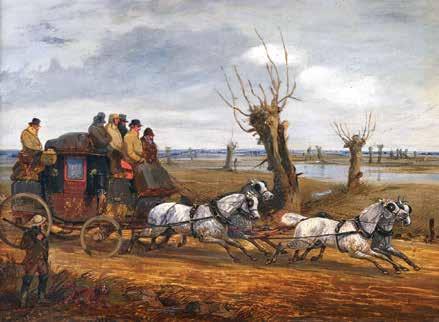

(British, 1792-1867)
The Royal Post Signed and dated 1834 Oil on canvas, 15 x 23 inches

HENRY
( British, 1785-1851)
The Cesarewitch, a pair Both signed and dated 1849 and inscribed as titled Oil on panel, 8 x 12 inches
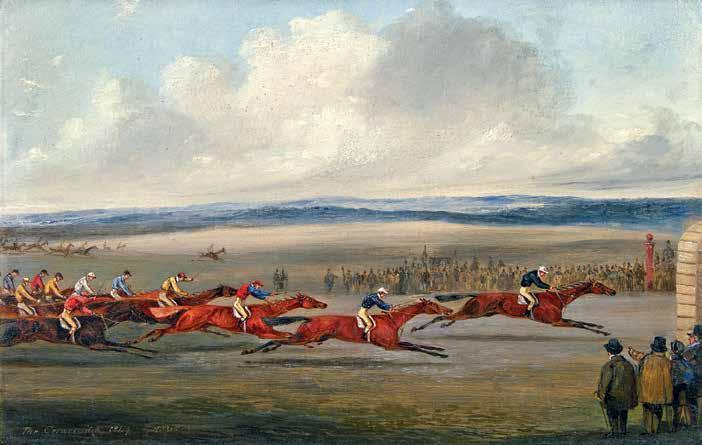

(British, 1810-1894)

The London - Dorking Coach Signed
Oil on canvas, 11 x 16¾ inches
(British, fl. 1765-1825) Oxford to London Coach Oil on canvas, 17 x 24 inches

11.
HENRY ALKEN, SR. (British, 1785-1851)
Taking a Fence Signed and dated 1816 Oil on panel, 14½ x 18¼ inches

(British, 1763-1840)
The Earl of Bridgewater on a Hunter with Hounds Oil on canvas, 27 x 35 inches

(British, fl.1869-1903)
The Punchestown Races - Conyngham Cup, 1872, County Kildare, Ireland, a set of four All signed Oil on canvases, 16 x 30 inches See Appendix for further details
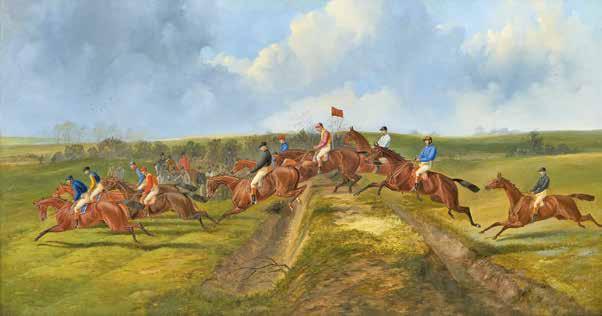



(British, fl. 1868-1930) Prominent Horses, Jockeys, and Silks from 1900 Signed and dated Watercolor and gouache on paper, 14 x 21 inches See Appendix for further details

(British, 1846-1936)
Mrs. Ambrose Clark’s Bay Mare ‘Meadowsweet II’ by ‘Yankee’ out of ‘Campo’ with Michael Tighe Up Signed
Oil on canvas, 22 x 29 inches

16.
HENRY ALKEN, SR. (British, 1785-1851) Steeplechasing Scenes; a set of four All signed, Oil on canvases, 21 x 25 inches


Over the Brush
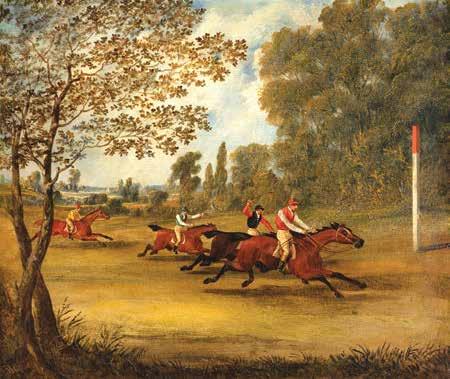
The Finish

(British, 1810-1865)
The Melton Hunt, Flying the Whissendine Brook and A Queerish Place, a pair Oil on canvases, 24 x 27½ inches


(British, 1763-1840)
Portrait of a Black Hunter in a Landscape Signed and dated 1826 Oil on canvas, 14 x 17 inches
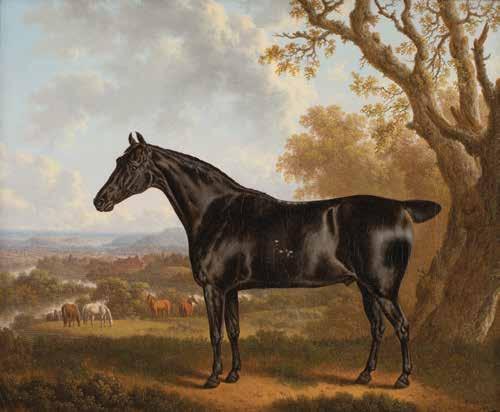
(British, 1830-1871)
The Horse Fair, Southborough Commons Oil on canvas, 29 x 45½ inches See Appendix for further details

20.
JOHN FREDERICK HERRING, SR. (British, 1795-1865)

Farmyard Friends Signed
Oil on canvas, 30 x 50¼ inches
21.
JOHN FREDERICK HERRING, SR. (British, 1795-1865)
Horses, Pigs and Poultry in the Farmyard Signed and dated 1847
Oil on canvas, 28 x 37¼ inches

(British, 1811-1891)

Coaching Scenes, a pair Both signed and dated 1878
Oil on canvases, 13 x 20 inches

(British, 1803-1877)
Wells-Lynn to London Royal Mail and The Night Coach, a pair Both signed Oil on canvases, 13 x 24 inches


(British, 1808-1893)
Spaniels Putting up a Pheasant Signed and dated 1864
Oil on canvas, 28 x 36 inches

(British, 1864-1949) Gone to Ground Signed and dated 1904 Oil on canvas, 16 x 20¼ inches

26.
SIR ALFRED JAMES MUNNINGS, PRA (British, 1878-1959)
Kempton Park Stables Signed Oil on panel, 14 x 28 inches

Provenance: Collection of Major Edwin Ody Kay, England A Private American Collection, Thence by descent
Literature: Sir Alfred Munnings, The Finish, London, 1952, illustrated opp. p. 72
Kempton Park Stables is an elegant and modern composition which compares favorably in its subject to works such as Horse Gossip at the Windsor Races or The French Noseband, Racing Stables at Windsor both in the collection of the National Museum of Racing, Saratoga Springs, New York. E.J. Rousuch, a founder of the National Museum of Racing and a great advocate of Munnings in America, described the artist as follows: “… the last painter in a brilliant tradition that wedded sport and society, man and animal, in vivid panoramas of the turf that recall the racing scenes of Degas, and the lyric glimpses of stable and the soil that evoke the English bucolic masters…he is a country man at heart. He paints the world of fashion in the chilly gray dawn of a hunt or in the shimmering heat of a summer day’s racing, and he always sees what is behind this: the stable or the paddock.”
While it has been suggested that the seated figure is Lady Munnings herself, two figures in the present work can be identified with some certainty. The standing man in a brown derby hat is Isaac Bell, a master of hounds and
Exhibited:
Possibly, New York, Scott and Fowles, Painting by Sir Alfred Munnings, KVCO, PPRA, November 12December 1, 1951 (as Anarchist in a Stable Scene) Sheffield, Graves Art Gallery, Modern Pictures from Major E.O.Kay's Collection, February 1953
friend to Munnings. He painted his portrait and remarked in his autobiography: “The painting of Ikey Bell's portrait at his house in Kilkenny would fill pages were I to tell of all that happened and the people I met there.” (Sir Alfred Munnings, The Second Burst, London, 1951, p. 139). Bell would give Munnings a favorite grey, Isaac, as partial payment for the portrait and who would appear in many later paintings. There is an oil study of Isaac Bell, done for the present work, in the collection of the Munnings Museum at Castle House, Dedham. The second known figure is Munnings' horse, Anarchist. In the third volume of his autobiography, The Finish, Munnings describes the experience of painting Anarchist: "Then Anarchist, one of the last remaining horses… such a sort, beautifully clipped and all, mane water-brushed... and I start…I go for the attitude… he is certainly a wondrous doer; for he is now big, sleek and fit, and makes the most perfect model. A regular 16.2 Chaser. I’ve noticed him of late giving a fling or a buck from sheer good health.”
Bond Street Galleries, London (after 1956) where probably purchased by Edgar Cooper-Bland with whom it remained until his death in 1985
Sale: Christie’s, London, 15 March 1985, lot 254 Richard Green, London A Private Collection, Florida
The Start was probably painted circa 1950 and is part of a series of pictures that Munnings painted in which he sought to capture the kinetic energy of horses in movement – the rhythmic pounding of hooves on the turf, the glis tening sweat on the muscular flanks as they surge forward in unison, nostrils flared and eyes wild with the thrill of the race. Details are undefined as though we are glimpsing the horses and jockeys as they race past our view, the paint is applied with bravura and energy. Munnings has used a clever compositional trick of suggesting the action beyond the edges of the painting. To focus the viewer’s attention on the field coming into line Munnings eliminates any suggestion of starter, spectator or grandstand. The vibrant and starkly contrasting tones of blue, pink and yellow lead the viewer’s eye in a haphazard fashion which acts as a metaphor for the action to come. The flash of color only momentarily occupies the space that we are seeing, a glimpse of fast action which is fleeting and invigorating. This arrangement helps to convey the powerful excitement and anticipation of the scene; emotions which the artist himself always felt as a race came under starters orders. It is a painting entirely focused on depicting forward momentum as the horses lunge into movement, power fully breaking into a gallop, all moving in the same direc tion but at different paces.
Munnings included a painting of the start of a horse race in virtually every Royal Academy exhibition between 1940 and his death in 1959. By the Second World War he had returned to his country house in Dedham, a mere forty
Exhibited: London, Royal Academy, Diploma Exhibition, 1956, no. 250
or so miles from Newmarket. This gave him the oppor tunity to make regular visits to the racecourse throughout the season where he could take inspiration from three or four races a day. Munnings even set up a studio, courtesy of the Jockey Club, in an old rubbing barn. In his auto biography Munnings described Newmarket racecourse: “I am standing on the course - the most beautiful course in the world... I am looking at the scene, the old, old scene - a centuries old scene. Horses come up the course looking like those of years ago.... Bright colors in the sun just the same as of yore.... What a sight for the artist! With the long shadows and the lights on the boots, lights on the horses.... This is the best picture I have ever seen...” It never failed to inspire him on his countless visits.
At Newmarket, the clerk of the course gave Munnings special permission to position his car at the starting post and he used his horse box as a portable studio from which to paint the action. He was not viewing from afar - he was painting beside the horses and the jockeys and this gives the paintings a palpable realism as he was able to feel the nervous tension and the thrill of the moment of the start. Munnings was less interested in the end of a race – his fascination was the anticipation of action in the moments before the race or the initial surge as the race begins when the horses, jockeys and spectators erupt into a mass of energy and excitement. The present picture captures that moment beautifully.
27.
SIR ALFRED JAMES MUNNINGS, PRA (British, 1878-1959)
The Start Oil on board, 16 x 20 inches

28.
SIR ALFRED JAMES MUNNINGS, PRA (British, 1878-1959) Study of Horses Heads Signed
Oil on panel, 18 x 24 inches

Provenance: Bond Street Galleries, London Sale: Christie’s, London, 8 May 2009, lot 123 Richard Green, London Purchased from the above by the present owner
This appears to be a study for My Wife, My Horse and Myself (Munnings Art Museum, Dedham) and Our Mutual Friend the Horse, two similar compositions begun in 1928. In both pictures Violet, Lady Munnings is mounted side-saddle outside the Munnings home, Castle House at Dedham, while the artist himself stands in front looking out with an attitude of confidence.
My Wife, My Horse and Myself, probably featuring the bay horse Anarchist, is one of Munnings’ greatest paintings, exhibited at the Royal Academy in 1935 and again 1955 under the title The Bay Horse and Ourselves
Our Mutual Friend the Horse was exhibited in 1953 before being re-worked in 1954, the original chestnut horse Master Munn being replaced by Rufus. This version was then published as a print by Frost and Reed.
A photograph of Munnings taken in 1956 shows the artist with My Wife, My Horse and Myself and many of the sketches for it, several of which closely resemble the present work (these sketches are now in the Munnings Art Museum Collection).

We are grateful for the assistance of the Curatorial team at The Munnings Art Museum, Dedham.

Crossing the Ford
Provenance:
Acquired directly from the artist; thence by descent until 2012
Sale: Sotheby's, London, May 10, 2012, lot 70 Richard Green, London Purchased from the above by the present owner
Munnings is known to have painted three large versions of The Ford, one of which was exhibited at the Royal Academy in 1911. Munnings was a staunch advocate of painting en plein air and the pictures held an important place in the artist’s oeuvre when he was able to experiment with his observations of the horses as they repeatedly crossed the shallow waters in front of him and he rapidly captured the effects. The artist wrote in 1950; ‘I still possess those large five-foot studies. Looking at them now brings back the scene afresh. I hear myself shouting “Hi! Wake that dun horse; shove his head up!” or, to a boy with a pole, “Keep the water moving”’ (Sir Alfred Munnings, An Artist's Life, 1950, p. 239). Two of these pictures are now in the collections of Wolverhampton Art Gallery and the Sir Alfred Munnings Art Museum in Dedham. The finished painting to which they and the present watercolor relate is now in the collection of the playwright Lord Andrew Lloyd Webber.
Dated 1908, this watercolor is an early precursor to the oil paintings of Crossing the Ford, which were painted in the summer of 1910 in the Ringland Hills. The artist wrote of these pictures in his autobiography; ‘On grey days my subject was by the shallow edge of the millstream, where farm-horses watered ... The grey-weather subject I prepared for was The Ford - grey water and dark reflections broken by lines of the current. Again what a subject! ... Standing on rising ground, looking down on the leading ponies coming out of the water, I spaced the designcutting out the sky - using the distant country for the top portion of the picture. Ponies, water, reflections, filled the rest of the space.’
Munnings’ use of watercolor was masterful and the pictures he painted of horses crossing the ford show his use of the medium to best effect. Flecks of white bodycolor
perfectly capture the splashing of water beneath the hooves and on the wet flanks of the horses. The bleeding of the pigments creates a hazy effect of morning mist, while the brilliance of the white on the central pony shows the sunlight on the principal focus of the picture. This watercolor is among the earliest depictions of the beautiful white pony Augereau, who became a principle equestrian model for Munnings’ paintings. He was named by Munnings after seeing a matinee performance of a play called ‘A Royal Divorce’ in which a character continuously exclaims, “I swear it on the word of an Augereau.” Augereau, wrote Munnings, ‘not only [brought] me wealth, but [earned] his keep a hundredfold.’ The groom who appears in this work and many of Munnings pictures of this period was named ‘Shrimp’; in Munnings’ words ‘an undersized, rough, artful young brigand’ who ‘slept under the caravan with the dogs’.
The ford pictures are studies in earth tones, and painted with great energy that captures both the movement of the horses as well as the water beneath their hooves. Munnings had been fascinated by water since his childhood and wanted to recreate the light reflected in the ripples and currents of the water as it travelled its course, or was disturbed by the movement of the horses in the shallows. He had a profound knowledge of horses and a finely tuned understanding of their behavior. It was this interest and love of the subject he depicted that gave his paintings their conviction and energy. Munnings never tired of painting horses and their riders, and summer after summer he painted ponies. His understanding of their various natures and moods meant that he was able to observe the differences between them and could capture their character as a successful portrait painter could capture the personalities of their human sitters.
29.
SIR ALFRED JAMES MUNNINGS, PRA (British, 1878-1959)
Crossing the Ford Signed and dated 1908 Pencil, watercolor and bodycolor, 11 x 13 inches

30.
SIR ALFRED JAMES MUNNINGS, PRA (British, 1878-1959)

Helter Skelter Signed and dated 1911
Watercolor and gouache on paper, 171/8 x 213/8 inches
Provenance: acquired from the artist thence by descent Bonhams, London, July 11 2006, lot 10 with Richard Green, London, 2006 Private Collection, UK 2006 acquired from the above Private Collection, America 2016 to present
Exhibited:
London, Royal Institute of Painters in Water Colours, 1911, no. 362
London, Richard Green, British Sporting Paintings, 2006 London, Richard Green, Sir Alfred Munnings, KCVO, PRA, Mendham, 1878 – 1959 Dedham, An Artist’s Life, November 14 – December 14, 2012
Middleburg, VA, National Sporting Library and Museum. Munnings: Out in the Open, 2013 p. 8, plate 4
Munnings captures the excitement of a herd of ponies being driven through dense undergrowth, partly silhouetted against open sky. The driver, on a bay pony, is Shrimp (Fountain Page), the gypsy boy - ‘an undersized, tough, artful young brigand’ - who was Munnings’ favorite model in the early years of the twentieth century. Munnings rose magnificently to the challenge of portraying a group of horses moving at speed in three quarter-view, taxing his knowledge of horse anatomy and behavior in the unforgiving medium of watercolor, which dries quickly and does not allow for mistakes.
Helter Skelter is part of the series Coming through the Gap, which Munnings worked on in 1910 and 1911. The largest oil in this series was the 30 x 40 inch painting formerly in the Bunting Collection. It is very similar to the present watercolor, with the same configuration of ponies and Shrimp raising his whip at the left. Another oil painting from the series, Coming through the Gap of 1911 shows ponies being driven through a more open patch of gorse with Shrimp far in the background. Helter Skelter is Munnings’ only watercolor treatment of this theme.
Literature: British Sporting Paintings. London, Richard Green, pp. 88, illustrated 89, no. 32
Sir Alfred Munnings, KCVO, PRA, Mendham, 1878 –1959 Dedham, An Artist’s Life. London, Richard Green, 2012, illustrated no. 18
Munnings: Out in the Open, Middleburg, VA, National Sporting Library & Museum, 2013, pp. 8, illustrated p. 9 Munnings, Alfred Munnings, Sir Alfred J., The Autobiog raphy of Sir Alfred Munnings K.C.V.O., P.P.R.A.: An Artist’s Life. London, 1950, p. 207
The white pony which lights up the center of the composition just below the burst of grey blue light from the sky, is probably Augereau, which Munnings bought from his friend and horse dealer Drake when he was living at Church Farm, Swainsthorpe in his early years of independence as a painter. The use of a white pony or horse to provide a brilliant focus is a favorite motif of the artist.
Munnings was a superb water colorist, painting many works in this medium at the beginning of his career. After the early 1920’s he almost totally abandoned watercolor to concentrate on the more lucrative medium of oil. He exhibited at the Royal Institute of Painters in Watercolours from 1899 to 1916 and at the Royal Society of Painters in Watercolours from 1921-1937.
(British, 1811-1891)
Steeplechasing Scenes, a set of five One signed and dated 1886



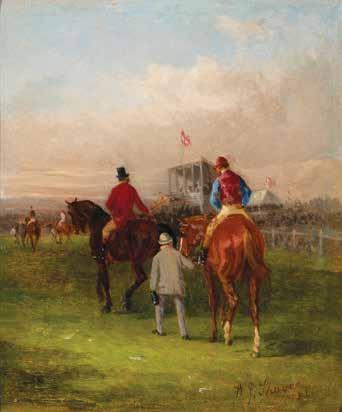
Oil on panels, 7 x 5¾ inches, 3¾ x 5¾ inches

(German, 1843-1924)
Portrait of St. Maclou by St. Simon out of MiMi with H. Mornington Cannon Up Signed, dated 1902 and inscribed St. Maclou Oil on canvas, 31 x 41 inches

33.
HEYWOOD HARDY (British, 1843-1933)
The Meet Signed Oil on canvas, 18 x 24 inches

34.
(British, fl. 1860-1918)

A Blank Day and End of a Good Day, a pair Both signed and dated 1907 Oil on canvases, 24 x 12inches
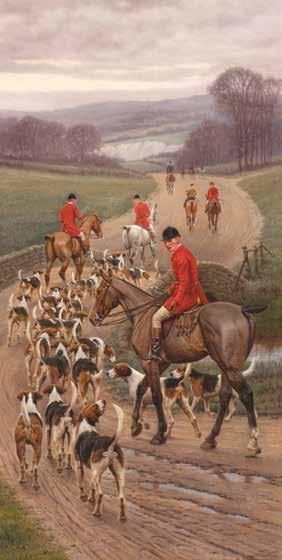
1912-1989)
The Vale of White Horse Moving Off from Lushhill Signed Oil on canvas, 28 x 42 inches

36.
(British, 1880-1950) Kerry Beagles, Hounds of the Scarteen Hunt, Co. Limerick, Ireland Signed and dated 1917 Watercolor on paper, 35 x 53 inches
See Appendix for further details

(British, fl. 1872-1943)
A Hunt Passing a Coach, c. 1920 Signed
Oil on canvas, 16 x 24 inches

38.
(British, fl. 1872-1943) Jogging Home, c. 1920 Signed
Oil on canvas, 16 x 24 inches

39.
GILBERT HOLIDAY (British, 1879-1937) The End of a Good Run Signed Pastel on paper, 13 x 12 inches

40.
GEORGE WRIGHT (British, 1860-1942) Full Cry Signed Oil on canvas, 28 x 36 inches

Located in the north of the United Kingdom the Highlands encompass the counties covering the extensive area between North Yorkshire and the northern most reaches of Scotland. The territory in this region contains a dramatic and diverse topography with frequently occurring extremes of elevation. The landscape is composed of a mix of vast moorland areas punctuated with dense forestry tracts along with low valleys and swift flowing river gorges, often rising to significant mountain peaks. The Highlands provide a unique rural environment and over the past two hundred years artists have been attracted to this northern region to paint its distinct landscapes, people, animals, and the rural sporting pursuits, which celebrate British country life.
When Queen Victoria and Prince Albert acquired the Balmoral Estate in Aberdeenshire, Scotland in 1852, the public took note, and the Highlands became a fashionable destination; a seasonal migration that was facilitated by an expanding British railway system. Balmoral was and remains today a favorite private property of the Royal Family which is not a part of the Crown holdings. The field sports of the highlands, first practiced and widely popularized by the royals and their guests at Balmoral, included angling for salmon with fly and rod, stalking for stag, and shooting driven grouse; activities of which developed traditional methods of application and attire, standards which have carried forth through the present in pursuit of the wild game found there.
The Highland landscape was also home to the development of unique breeds of livestock suited to the rugged terrain and often harsh weather of these northern territories; Highland cattle, sheep, ponies, and herds of managed wild deer being the primary examples. To be sure highland country farming and forestry was a difficult and challenging way of life, although Prince Albert and Queen Victoria’s love of Balmoral Castle, its 50,000 acres, its livestock and wild game served as an inspiration to their citizens. These passions fueled the Queen’s desire to commission paintings of the highland way of life, subjects which are found here in this section of the catalog. Sir Edwin H. Landseer and Richard Ansdell were perhaps the most renown 19th century artists to paint the highland life and field sports. Today, nearly two centuries later, their paintings, those of their contemporaries, and modern depictions of highland life, remain popular and sought after collectibles.
(British, 1833-1904) Early Morning in June Oil on canvas, 23 inches diameter

42.
(British, 1811-1886)

On Guard Signed
Oil on canvas, 45 x 39 inches
(British, 1864-1949)
Setters on the Moor Signed
Oil on canvas, 24 x 19 inches

(British, 1898-1985) Covey of Grouse Signed Watercolor on paper, 21 x 29 inches

JAMES
(American, 1907-?)
At Rest on the Moor Oil on canvas, 24 x 30 inches

Sir Edwin Henry Landseer was something of a prodigy whose talents were recognized early on by members of the Royal Academy. At the age of just 13, in 1815, he exhibited works there as an “Honorary Exhibitor”. He was elected an Associate at the minimum age of 24, and an Academician five years later in 1831. Landseer’s first visit to the Highlands inspired him to return every autumn and to make Scottish subjects the focus of his painting.
The passion for Scotland amongst wealthy and aristocratic Englishmen rose dramatically during Landseer’s lifetime. His work appealed to those who often travelled to the highlands either in search of sport or the sublime beauty of the highland landscape.

The novels of Sir Walter Scott gave life to the romantic way of the life of the highlanders in literature, while Landseer, the favorite artist of Queen Victoria, was one of the first painters to give visual expression to the romantic view of the Highlands and Highland life. In the 1820s, when this picture was most likely painted, it was still possible to overlook the reality of extreme poverty and economic decline that the highlanders faced. Unlike many visitors, Landseer was not oblivious to the abject poverty that many faced in the region and his sympathetic rendering of the shepherd in the present work reflects his understanding of the characters he met. Scenes of Highland life, as opposed to landscapes, are relatively rare before Landseer’s time. In many ways Landseer was breaking new ground, and making, rather than following a movement. Landseer’s pictures tell a story, communicate a drama and express a feeling; and they continue to affect our attitudes today.
Sir Edwin Landseer’s Portrait Study of a Highland Shepherd shown opposite was a preliminary head study for the fullfigured painting titled A Highland shepherd - a sketch, an oil on board, painted in the early 1820s, originally offered for sale at Christie’s, London in 1900 and then again at Christies, London in November of 2001. (figure 1)
46.
SIR EDWIN
(British, 1802-1873)
Portrait Study of a Highland Shepherd Oil on panel, 10 x 7 inches

47.
LOUIS BOSWORTH HURT (British, 1856-1929)
In Far Lochader – Showery Weather Signed
Oil on canvas, 24 x 40 inches
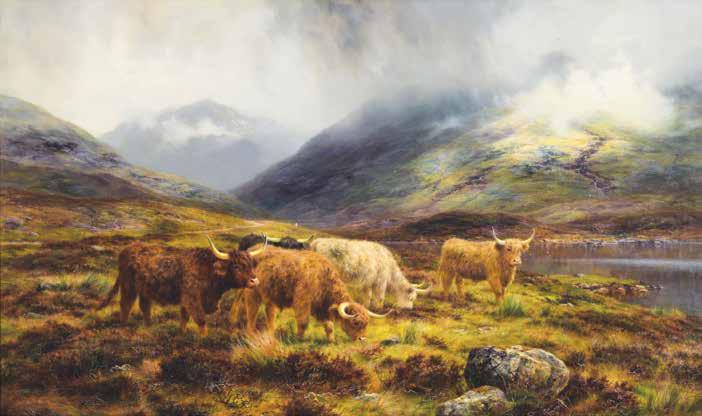
(British, 1815-1885) Cutting out the Rams Signed and dated 1860 Oil on canvas, 30 x 60 inches

Plate 13
JOHN STURGESS (British, fl.1869-1903)
The Punchestown Races - Conyngham Cup, 1872, County Kildare, Ireland
Provenance:

Mr. Emanuel Jay Rousuck, New York Newhouse Galleries, New York, A Private Collection, Long Island, New York until 1987 By descent in the family until the present
Engraved:
Edward Gilbert Hester (British, 1843-1903), a set of four aquatint engravings published Dublin: Thomas Cranfield, June1,1874; republished as color lithographs Arthur Ackerman, London
The Start:
Left to right: Mr. Whyte on Bashful, Mr. Moore on Curragh Ranger, Mr. Comerford on Chisel, Mr. Exshaw on Findestop, Capt. McCalmont on Magenta, Mr. Oldham on Ireland Yet, Mr. St. James on Lamp, Mr. Thomas on Star of the Sea, Capt. Smith on Heraut D’Armes, Mr. Beasley on Hubert, Mr. Long on Ruric and Capt. McFarlane on Waterford.
The Finish:
Left to Right: Capt. Smith on Heraut D’Armes, Mr. Moore on Curragh Ranger, Mr. Whyte on Bashful, Capt. MacFarlane on Waterford, Mr. Beasley on Hubert, Mr. Thomas on Star of the Sea and Mr. St. James on Lamp.
Plate 14
PERCY EARL (British, fl. 1868-1930)
Prominent Horses, Jockeys, and Silks from 1900
A label on verso reads “Diamond Jubilee, winner of the Triple Crown of 1900 for The Prince of Wales, shown in center of a group of the most prominent jockeys of the season. (left to right) K. Cannon, colors of J. Musher; H. Jones, colors of The Prince of Wales; S. Loates; Lester Reiff; Otto Maddien; Mornington Cannon, colors of the Duke of Portland; F. Rickaley; and J.H. Morton.
BENJAMIN HERRING, JR.(British, 1830-1871)
Painted after a composition by the artist’s father, John Frederick Herring, Sr. (1795-1865).
In the original version painted in 1857, Herring, Sr. has included an extremely rare self-portrait in this major late work. He is depicted standing at far left in a buff top hat. In the center of the composition is the white Arabian Stallion, Imaun, with rider up. He was one of the first of four horses presented to Queen Victoria by the Imaun of Muscat. The Queen eventually presented him to the Clerk of the Royal Stables, who sold him at Tattersall’s. Herring, Sr. was the buyer and Imaun appears as a favorite model in numerous compositions. In one instance, when Herring needed a model for “dead horses” in his painting of The Battle of Waterloo, Imaun was taught to lie down. The original bill of sale from Herring, Sr. indicates that A Horse Fair on Southborough Common was sold on April 24, 1858 for £300.
Plate 36
REUBEN
(British, 1880-1950)
Kerry Beagles at Kennels, Hounds of the Scarteen Hunt, County Limerick, Ireland, 1917
Each hound’s name is noted along the frame with birth dates as follows: Gamester, 1912; Dasher 1912; Watchful 1910; Hilda 1912; Kerry 1910; Dexter 1910
Adam, Emil
Portrait of St. Maclou by St. Simon Out of Mimi with H. Mornington Cannon Up, 1902 (Plate 32)
Alken, Samuel Dapping for Trout (Plate 2)
Alken, Samuel Henry A Coach and Four Passing a Sportsman and A Coach and Four Topping the Hill, a pair (Plate 6) The London - Dorking Coach (Plate 9)
Alken, Sr., Henry Steeplechasing Scenes; a set of four (Plate 16) The Cesarewitch, 1849, a pair (Plate 8) Taking a Fence, 1816 (Plate 11)
Ansdell, Richard Cutting Out the Rams, 1860 (Plate 48)
Armfield, George Spaniels Putting Up a Pheasant, 1864 (Plate 24)
Barker, John On Guard (Plate 42)
Barret, George Going Out in the Morning, Foxhunting with HRH The Prince of Wales (Plate 5)
Binks, Reuben Ward Kerry Beagles, Hounds of the Scarteen Hunt, Co. Limerick, Ireland, 1917 (Plate 36)
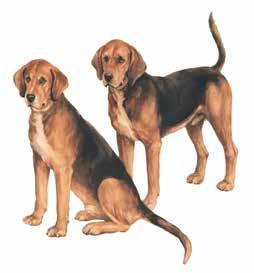
Bird, John Alexander Harrington
Mrs. Ambrose Clark’s Bay Mare ‘Meadowsweet II’ By ‘Yankee’ Out of ‘Campo’ With Michael Tighe Up (Plate 15)
Cordrey, John Oxford to London Coach (Plate 10)
Dalby, John Flying The Whissendine Brook and The Melton Hunt, A Queerish Place, a pair (Plate 17)
Douglas, Edward A. S. A Blank Day and End of a Good Day, 1907, a pair (Plate 34)
Earl, Percy
Prominent Horses, Jockeys, and Silks from 1900 (Plate 14)
Gilpin, Sawrey
Going Out in the Morning, Foxhunting with HRH The Prince of Wales (Plate 5)
Hardy, Heywood
The Meet (Plate 33)
Harrison, John Cyril Covey of Grouse (Plate 44)
Henderson, Charles Cooper Wells-Lynn to London Royal Mail and The Night Coach, a pair (Plate 23)
Herring, Jr., Benjamin The Horse Fair, Southborough Commons (Plate 19)
Herring, Sr., John Frederick Farmyard Scene (Plate 1) Deer Park at Windsor, 1835 (Plate 3) Farmyard Friends (Plate 20) Horses, Pigs and Poultry in the Farmyard, 1847 (Plate 21)
Holiday, Gilbert
The End of a Good Run (Plate 39)
Howell, Peter Down the Stretch (Headed at a Distance), 1984 (Plate 49)
Hurt, Louis Bosworth
In Far Lochader – Showery Weather (Plate 47)
Landseer, Sir Edwin Portrait Study of a Highland Shepherd (Plate 46)
Lyne, Michael
The Vale of White Horse Moving Off From Lushhill (Plate 35)
Macgregor, Jr., James Duncan
At Rest on the Moor (Plate 45)
Munnings, Sir Alfred James
Crossing the Ford, 1908 (Plate 29) Helter Skelter, 1911 (Plate 30)
Kempton Park Stables (Plate 26)
The Start (Plate 27) Study of Horses Heads (Plate 28)
Neale, Edward
Early Morning in June (Plate 41)
Pollard, James
Departure of The Royal Mails, The General Post Office, London (Plate 4)
The Royal Post, 1834 (Plate 7)
Coaching Scenes, 1878, a pair (Plate 22)
Steeplechasing Scenes, 1886; a set of five (Plate 31)
Sturgess, John
The Punchestown Races - Conyngham Cup, 1872, County Kildare, Ireland, a set of four (Plate 13)
Towne, Charles
The Earl of Bridgewater on a Hunter with Hounds (Plate 12)
Portrait of a Black Hunter in a Landscape, 1826 (Plate 18)
Wardle, Arthur
Gone to Ground, 1904 (Plate 25) Setters on the Moor (Plate 43)
Wells, John Sanderson
A Hunt Passing A Coach, c. 1920 (Plate 37) Jogging Home, c. 1920 (Plate 38)
Wright, George Full Cry (Plate 40)

Opposite:
BENJAMIN HERRING, JR. Plate 19 (detail)
Back Cover: 49. PETER HOWELL (British, b. 1932) Down the Stretch (Headed at a Distance) Signed and dated 1984 Oil on canvas, 24 x 30 inches
PETER L. VILLA
LLC American & European Paintings from the 18th – 21st Centuries www.peterlvillafineart.com
Sporting Paintings & Sculpture F. Turner Reuter, Jr. www.redfoxfineart.com
